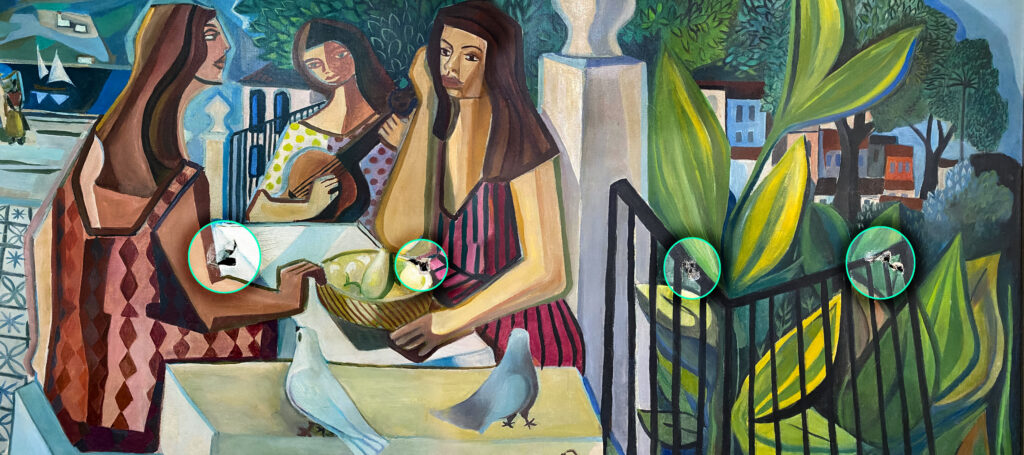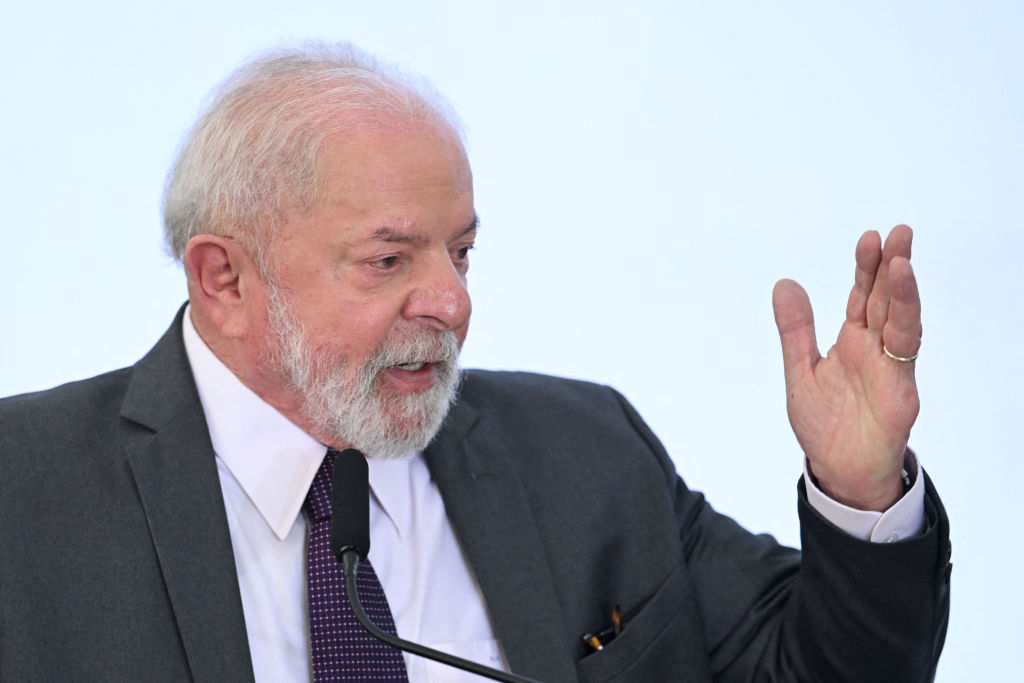This article has been updated.
BRASÍLIA – When you first walk into the Palácio do Planalto, Brazil’s presidential palace, it seems like the clock has been turned back 20 years to a more optimistic, placid era.
There, once again, are smiling photos of President Luiz Inácio Lula da Silva. The elegant mid-century architecture of Oscar Niemeyer sparkles as ever. But then you take the elevator to the third floor, and you see it: the windows still shattered, like glass spiderwebs, after the failed insurrection of January 8. A painting by the celebrated Brazilian artist Emiliano Di Cavalcanti, crudely stabbed in seven different places by a supporter of Jair Bolsonaro, packs an especially poignant punch. Some in the palace say the painting may not be restored, but left with its scars, as a permanent reminder of that day’s disgrace.

Imagine seeing this in your workplace every day, and you will start to understand how Lula and his allies see their country—and the presidency as it nears the 100-day mark. Lula’s return to the Planalto has been marked by intervals of welcome normalcy–but also a contentious, unexpectedly bitter tone that has alarmed many in business and financial markets, as well as the moderate voters who were key to his narrow victory last October. As Lula has spent valuable time and capital lashing out at Brazil’s independent central bank, or the judge who sentenced him to prison last decade, while also dragging his feet on announcing a critical economic framework for the next few years, some have speculated the president’s age (77) is catching up with him. Others say that, in contrast to his first period in office (2003-10), Lula is either not receiving good advice, or not willing to listen.
After recently spending a week in Brasília, though, a different explanation came to mind: Lula is behaving as if he sees threats everywhere, and his presidency runs the risk of collapse.
And here’s the thing: He’s not wrong.
Let me put my own opinions aside, and try to explain what the world looks like right now to those inside the Planalto:
Yes, they say, Lula is back where he belongs, after being jailed in 2018 and thus barred from running in an election he would have otherwise won. But he faces the same array of enemies and false allies, in Congress and elsewhere, who conspired in 2016 to impeach Dilma Rousseff (a “coup,” Lula and his allies continue to insist) and later put him in prison. In fact, the threat today is much worse: The armed forces remain loyal to Bolsonaro, came close to supporting his plan to steal or cancel the 2022 election, and then aided or at least tolerated the rioters who invaded government buildings on January 8 to try to restore Bolsonaro to power. That coup attempt failed, but the embers for a future uprising remain, to be stoked by fake news, Evangelical pastors, a shady Trumpian network of global conservatives—and Bolsonaro’s own return to Brazil on March 30 after spending the last few months in exile in Orlando.
Meanwhile, their thinking goes, both chambers of Congress have tilted even further right, run by fickle operators who once supported Bolsonaro and could flip again overnight, dooming Lula’s entire agenda for the next four years, if their demands for money and favors aren’t met. Brazil’s conservative business world will do anything to prevent Lula from raising taxes or otherwise increasing spending needed to protect the Amazon, attenuate the social crisis and otherwise rebuild the country (and keep political allies happy). And finally, perhaps most worrying in the near term: A Bolsonaro ally controls the central bank, and has kept interest rates so stratospherically high—either because of loyalty to his former boss, or an extreme strain of neoliberal orthodoxy—that Brazil’s economy is doomed to enter recession later this year. That could set off a death spiral of falling presidential approval and institutional turmoil in a country where two of the last five elected presidents were impeached after losing control of the economy, and today’s extreme polarization means that risk is more present than ever.
What to make of all this?
Talk to some in the Brazilian media or on Faria Lima, São Paulo’s Wall Street, and they roll their eyes at the government’s “paranoia.” But look closer, and at least in some areas, Lula appears to have a point. Roberto Campos Neto, the central bank chief, is admired in many circles—but he also voted last October while wearing a yellow and green Brazilian soccer jersey, the equivalent of publicly declaring his vote for Bolsonaro, which was, at best, ill-advised for a neutral technocrat. Even many in financial markets admit–in private–that keeping Brazil’s benchmark rate at 13.75%, at a time when annual inflation is 5.36% and slowing, is difficult to defend. Meanwhile, Arthur Lira, who heads the congressional House of Deputies, has made clear that Lula’s economic agenda is dead on arrival unless he agrees to maintain some version of the so-called “secret budget” scheme of the Bolsonaro years, in which legislators control a share of discretionary spending with no oversight—a recipe for waste and corruption that will, inevitably, be blamed on Lula, who for obvious reasons cannot handle another major scandal.
But the most worrying area ties back to the defaced painting at the presidential palace. On the one hand, institutions survived the strain of the Bolsonaro years, and the climate in Brasília–save for the central bank issue–is notably more harmonious today. But just as we saw in the United States after the 2020 election, stories are only now beginning to trickle out about just how close the country came to the abyss. After my week in Brazil, and private conversations with several figures, I now believe democracy was in significantly greater danger throughout 2021 and 2022 than I previously appreciated. Only the interventions of some key individuals, both inside and outside Brazil, may have dissuaded Bolsonaro from following through on his threat to suspend the election until the electronic voting system was replaced, for example, or finding a pretext to deploy the military on the streets. Until these stories are told publicly, we can only evaluate what we see, such as Lula’s decision to abruptly replace the head of the army in January after just three weeks on the job. There may be little risk of a coup tomorrow, or even next year; but to believe that the page has been magically turned with Bolsonaro out of office seems naive.
Here’s the problem with all of this though: Even if Lula is correct in his assessment of threats, he is arguably making them worse through some of his actions. Warring publicly with Campos Neto and the central bank, for example, has pushed market rates even higher, as investors worry about further instability ahead. Lula’s desire to stimulate the economy through greater spending, and thus shore up popular support in the wake of a traumatic near-break with democracy, may have worked for President Joe Biden in 2021; but unlike the United States, Brazil does not have the world’s only reserve currency, and is in fact on a short leash with markets, given that the crash Lula’s party caused in the mid-2010s was eminently fiscal in nature. If Lula tries to go around the central bank and carve out exceptions to his just-announced “fiscal plan,” or stimulate the economy through less orthodox means, as some in his party are reportedly encouraging him to do, the blowback will surely get even worse.
Listen to this episode and subscribe to The Americas Quarterly Podcast on Apple, Spotify, Google and other platforms
To be sure, Lula still has several factors working in his favor. His approval remains relatively healthy, with 7 in 10 Brazilians describing his government as either “good” or “average.” The events of January 8, rejected by a large percentage of the Brazilian public, still have conservatives on the defensive. Bolsonaro has been further weakened by his absence from Brazil, and a damaging scandal involving a $3 million diamond necklace “gift” from Saudi Arabia for the former first lady. While visiting, I also sensed a clear thirst for normalcy; outside of Brasília, especially, people seemed eager to talk about literally anything but politics.
But Lula is right to be worried about what lies ahead: All over the Western world, we see countries where democracy is under duress, economic growth is elusive, and impatient, polarized societies want more than their leaders can possibly deliver. For Lula, whose campaign relied on nostalgia for the boom years of the 2000s, expectations may have always been too high. But ironically, many of his critics may be committing the same mistake, by comparing him to the “peace and love” Lula of his first term, and wondering why he sounds so “angry” today. Brazil has changed; the world has changed; and unless Lula and his allies can navigate the coming months with great skill, and perhaps a bit of luck, change may come once again, perhaps sooner than any of them would want.
This article was updated to reflect Bolsonaro’s return to Brazil and the announcement of Lula’s new fiscal framework plan.









